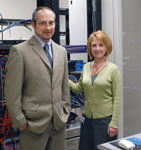
Part II: The Green Campus: Strategic Decisions
Smart business turns out to be good for the environment, too.
- By Dian Schaffhauser
- Jun 08, 2009
 |
As part of Delta College's commitment to sustainability, the campus community recycles cell phones, ink jet cartridges, and paper. |
When it comes to environmental savvy, Delta College (Mich.) is like a lot of small institutions of higher education: It has a passel of green efforts under way, which could fall under all sorts of headings.
The IT organization at the 11,000-student community college campus has virtualized its server operations and is on track to roll out a virtualized workstation pilot; it has digitized about 100 different forms and has instituted Web-based workflow to reduce the use of paper. The campus community recycles cell phones, ink jet cartridges, and paper, and students can buy fair-trade coffee in the cafeteria and participate in alternative spring break activities to perform service work. A chilled-water system even provides cooling for buildings during daytime hours in the summer. But unlike many schools of comparable size with various, uncoordinated, environmentally conscious programs in place, Delta's green plans are part of an overall strategy to take the institution green—including a strategic mission to take Delta as close to carbon neutrality as possible. And if Delta can make such missions reality, what's to stop any other American college or university from achieving the same goals?
"I think Delta is really ahead of the curve on a lot of this stuff," says Jason Stahl, chief information officer for SunGard Higher Education at Delta College. But that doesn't mean that other schools can't catch up. After all, they may already have the drivers in place for such an overarching green initiative. Delta's green ambitions, for example, grew out of efforts first undertaken by the Facilities Management office. Between 2002 and 2005, Facilities implemented green upgrades throughout the campus, including installation of energy-efficient windows, heat recovery systems, and intelligent HVAC and lighting.
Strategically Green
According to Linda Petee, the college's sustainability and risk management coordinator, "We've always been environmentally conscious of what we're doing. It just wasn't called sustainability back then. It was the way we operated, with bottom-line budget in mind." By the end of 2006, Delta's Facilities office had even developed a green philosophy, which it made public to the campus community.
. That was about the time colleges and universities across the country were first learning about the American College & University Presidents Climate Commitment, an environmental initiative that was launched by a consortium of environmental organizations—Second Nature, the Association for the Advancement of Sustainability in Higher Education, and ecoAmerica—to address what those organizations termed "the twin crises of energy sustainability and climate change." The commitment document, concise at just under two pages and three steps, lays out an ambitious set of actions to be taken by signatories. The first step, creating a comprehensive plan to achieve climate neutrality (expending no more carbon dioxide than a school can mitigate), consists of three phases:
- creating a structure for developing and implementing the plan within two months of signing;
- performing a comprehensive inventory of greenhouse gas emissions within one year; and
- developing the action plan for carbon neutrality within two years.
In the second step, the school also must commit to two tangible actions during the development of that larger plan, such as
- adopting an energy-efficient appliance-purchasing policy, and
- erecting new campus structures built to LEED Silver standards.
The third step is to make the action plans, inventory, and reports publicly available on the AASHE Web site.
Putting It All into Action
At Delta, President Jean Goodnow, who had signed the Climate Commitment on Sept. 18, 2007, asked Petee and Mike Finelli, instructor in the architecture technology program, to head up the college's first Sustainability Office and to co-chair a task force for sustainability on campus. Those efforts commenced in the same month and involved participation of a dean, facilities staffers, and faculty and student representatives. (Stahl's IT group wasn't part of the group.)
According to Petee, the mission of the task force was to come up with a set of short- and long-term recommendations directed at "how we could green up our campus to be more sustainable."
The committee met monthly, its efforts culminating in the Green Summit, which took place on "green" St. Patrick's Day 2008. The task force then pronounced sustainability as one of the defining roles of the college: The campus would henceforth be committed to evaluating any project or purchase it undertook from three angles—social, financial, and environmental.
"The idea is to find, in any project, the closest, most perfect balance of all three components," explains Petee. "Some are more [focused on] cost savings, but if we can incorporate some environmental savings in there, too, and have a social benefit as well, that's better than having something that's purely financial or even purely environmental.
7 No Fail Steps for Campus Climate Action
In his report, "Striving for Climate Neutrality on Campus," Michael Crowley, a program manager for consulting firmEnvironmental Health & Engineering and former assistant director of the Harvard University Green Campus Initiative, lays out seven steps for developing a campus climate action plan:
- Assemble a stakeholder-based committee to approach sustainability.
- Develop a greenhouse gas inventory and conduct an energy analysis.
- Prioritize greenhouse gas mitigation opportunities.
- Set greenhouse gas reduction targets and develop a climate neutral strategy.
- Conduct educational, research and community outreach efforts.
- Identify and implement financing strategies.
- Track progress and course-correct.
|
A good example: The campus introduced "Green Fridays" as a direct result of the summit. During the summer of 2008, in a pilot that lasted six to eight weeks, the college extended workdays to 10 hours Mondays through Thursdays, then closed campus operations as much as possible on Fridays. "We looked at all the student services we offered at that time," Petee recalls. "We wanted to optimize student services, but still save on utilities, heating, and air conditioning, as well as the commutes we were making out here." The outcome of the pilot needed to be evaluated from a financial and environmental perspective, as well as a social angle, she maintains. Questions they asked were: "How did it affect morale? Was it good for our working relationships? Was it good for our students?"
After moving the few Friday classes to Thursday and shifting work schedules (including in the IT department, where network maintenance activities typically took place on Fridays), "Everything pointed to the pilot results being very positive," she reports. So, this year, the school instituted the change as a permanent one, starting small in January by closing half an hour early on Fridays. By May, the campus shut down entirely on those days.
The next part of that Climate Commitment, the greenhouse gas inventory, was more challenging. After all, uncovering and counting every source of energy usage on a college campus, even a small campus, covers a lot of territory. As Petee describes the seven-month process, "We looked at how we purchase our gas, electricity, utilities, water, solid waste services. We looked at commuting habits, population, building size, trends in population growth, budget, endowments."
What's more, the research wasn't conducted for the most recent year alone; in order to measure progress they had made since making sustainability a driving force, Delta College officials went back over nine years of history to find a baseline year that would represent a pre-green state for the college. That job required meeting with each group on campus to explain the project; it meant requesting information from outside agencies, and conducting surveys. For example, the IT organization pulled together numbers on energy usage for its data center as well as for the 1,400 computers it supplies and supports on campus. The trickiest part, reports Petee, was measuring commuting habits. That involved conducting surveys among students, faculty, and staff to calculate trips per week, weeks per year, and miles per trip, as well as carpooling and public transportation habits—all of which were then adjusted according to the fluctuating price of gas for any given period.
 |
Delta College CIO Jason Stahl and Sustainability and Risk Management Coordinator Linda Petee are working to take the school as close to carbon neutrality as possible. |
The data were plugged into an online emissions calculation tool built in Excel and made available by
Clear Air-Cool Planet, a Northeastern nonprofit that works to help reduce carbon emissions. (A similar calculator, intended for campuses as well as other types of organizations, is provided by
The Climate Registry.) The results of the inventory were reported to AASHE at the end of 2008, and made available
online. Gross emissions at Delta College, according to the public report, totaled about 23,205 metric tons of carbon dioxide, or 4.2 metric tons per full-time enrollment for the 2000-2001 school year.
Internal analysis of those numbers, as well as potential benchmarking across institutions of comparable complexion, will come next, Petee explains. Although the Climate Commitment seeks climate neutrality, that's a tall order for a commuting college, she points out. "We may not be able to eliminate all the commutes, but we may be able to incorporate our carbon offsets on increased wind and solar energy, different kinds of energy consumption, and also our modes of travel. For example, can we buy carbon coupons when we have air travel, to try to offset that?"
Eventually, she envisions a campus where LEED sustainability guidelines are part of every new construction and renovation building project; where solar arrays will reduce dependence on the electrical grid; where biofuel will power campus transportation; and where a walking/biking trail will connect the school to Saginaw Valley State University (Mich.), as well as to the towns along the four-mile route. Many of those initiatives are already being piloted.
Not surprisingly, the college has found that sustainability is a draw. "People—students, staff, and faculty—are interested in campuses that are looking at that triple bottom line," Petee maintains. Her advice to other schools: "Call on your academic, service, facilities, and IT people, and find out what [green efforts] are going on right now. Gather all those initiatives. I think you'll be surprised by what you have. Then go forward from there to see what you're lacking, what you can promote the quickest, and what will have the most long-lasting benefits." It was this kind of coordinated effort—driven by the Climate Commitment environmental initiative—that transformed what otherwise might have been siloed green efforts at Delta.
About the Author
Dian Schaffhauser is a Nevada City, Calif.-based freelance writer; she covers technology and business for a number of publications. This article first appeared in the April 2009 issue of Campus Technology.